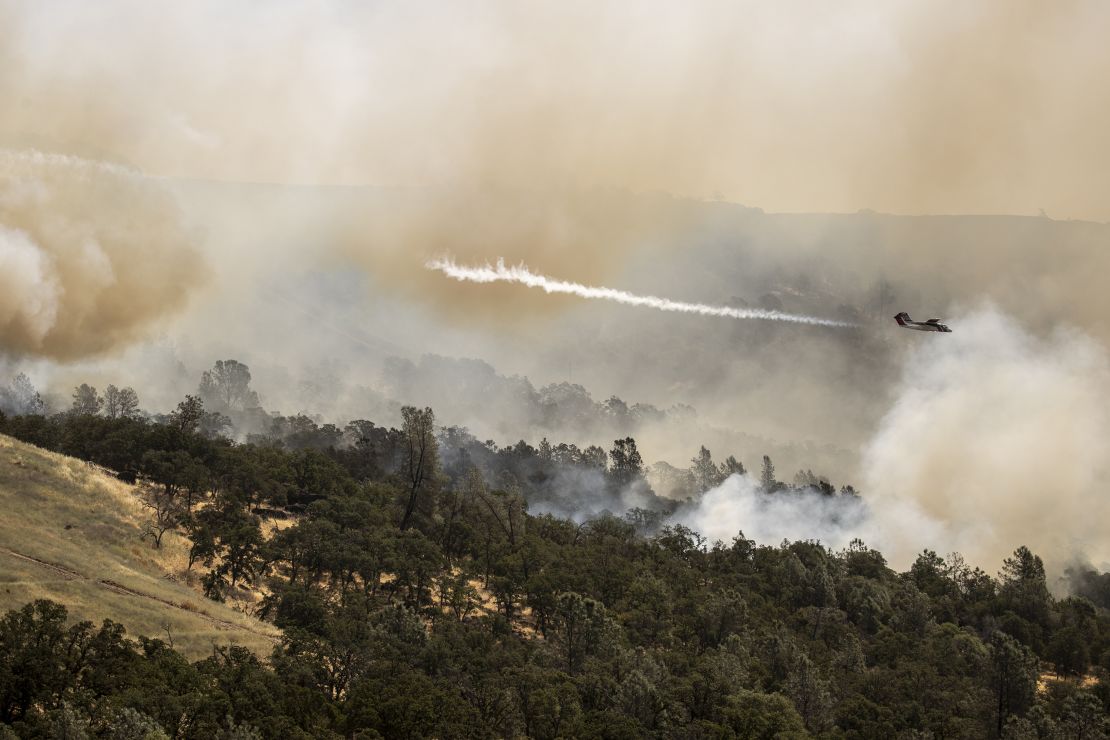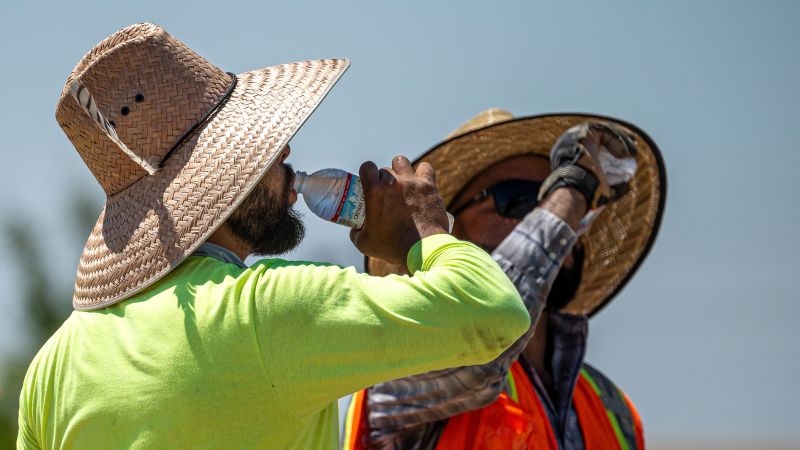CNN
—
An extremely dangerous, unusually long heat wave is intensifying and spreading along the West Coast — and relief won’t be coming for days.
Officials from California to Oregon to Washington to Nevada and Arizona are bracing for potential wildfires, opening cooling centers and warning residents to stay indoors and stay hydrated as the ongoing heat wave brings sweltering temperatures of 100 to 110 degrees Fahrenheit, with highs of over 120 degrees Fahrenheit in the southwestern U.S. desert.
And it’s only getting warmer.
Death Valley, California, could top 125 degrees on Sunday or Monday, setting a new daily record for that date. Las Vegas, Nevada, could also top its all-time high of 117 degrees on Sunday or Monday.
“Confidence is growing that this potentially historic heat wave will last for several days,” the National Weather Service in Portland warned, adding that the risk of heat-related illness will increase significantly.
According to the National Weather Service, extreme heat is one of the leading causes of weather-related deaths in the United States, killing hundreds of people each year.
In San Jose, California, a homeless man died Tuesday from the extreme heat, Mayor Matt Mahan said. The man was 69, mayoral spokeswoman Tasha Dean said, citing information from the Santa Clara Medical Examiner’s Office.
On the same day in Arizona, a 10-year-old boy died after experiencing a heat-related emergency while hiking with his family at South Mountain Park and Preserve, Phoenix police said.
“This is a DANGEROUS situation, especially for sensitive populations,” the National Weather Service in Los Angeles said. Residents were reminded to never leave anyone in a car, drink plenty of water, stay in the shade and wear light, loose clothing.
Saturday is expected to be the hottest day of this prolonged heat wave, with temperatures above 110 degrees Fahrenheit (43 degrees Celsius) common in California, away from coastal areas and at higher elevations, the National Weather Service said.
“This level of heat in parts of the Mojave Desert and the Sacramento/San Joaquin Valleys of California could pose a risk to everyone if proper heat safety precautions are not followed,” the weather service said.
Nearly 140 million people remain under heat warnings nationwide, particularly in the western states, where the heat wave is expected to last into the middle of next week.
According to the National Weather Service Portland, parts of Oregon can expect temperatures above 50 degrees Fahrenheit on Friday and the heat could last up to five days, with little relief at night.
In Multnomah County, Oregon’s most populous county, a state of emergency has been declared for this weekend as high temperatures are expected.
“I am especially concerned about the thousands of people who will be attending music festivals and sporting events this weekend. They will be spending a lot of time outside, may have limited access to shade and water, and may not recognize the risk,” Multnomah County Health Officer Dr. Richard Bruno said in a news release.
Bruno said the area has had few warm days so far this year and residents’ bodies have not yet acclimatized to the heat.
A previous heat wave in Oregon in 2021 killed dozens of people when electrical equipment failed due to the heat, knocking out tens of thousands of people and sending temperatures soaring above 100 degrees Fahrenheit.
While this heat wave isn’t expected to be as intense as the sweltering 2021, meteorologists are concerned about its longevity, meteorologist Noah Alviz of the National Weather Service in Portland, Oregon, told CNN. “It’s going to be four to five days of temperatures above 90 degrees Celsius or even triple digits of 100 to 105. That’s very unusual for this location,” he said.
“Triple-digit heat will extend northward into the Pacific Northwest and parts of the central Great Basin, with widespread highs soaring into the 90s and low 100s,” the National Weather Service said. “The duration of this heat is also of concern, as scorching, above-average temperatures are forecast to persist into next week.”
More than a dozen high temperature records were broken or tied on July 4 in multiple California cities, with Palmdale reaching 110 degrees Fahrenheit and Madera reaching 108 degrees Fahrenheit.
The extreme heat, strong winds and low humidity ensure that any forest fires spread quickly through the already arid vegetation.
Fire warnings are in effect across the West, including in the Thompson Fire area. Since it was reported Tuesday, the fire has burned more than 9,000 acres in Butte County, California. Thousands of people have been evacuated and hundreds of firefighters have battled the flames due to the extreme heat in the Oroville, California area.
According to Chris Peterson, spokesman for the California Department of Forestry and Fire Protection, also known as Cal Fire, 11 firefighters were injured in the wildfire, eight of whom suffered heat-related illnesses.
According to Cal Fire, the fire was 29% contained as of Thursday evening.
According to Cal Fire, the state is experiencing an active fire season, with 350,000 acres burned so far in 2024, compared to 19,700 acres this time last year.
According to Cal Fire, there are currently nearly two dozen active wildfires of varying sizes burning in California, with the Thompson fire being one of the largest.
“We’re seeing fires from the coast in San Diego, all the way up to the hills in Butte,” Cal Fire Deputy Director Nick Schuler told CNN on Wednesday. “Our firefighters are battling fires all across California and are often on the line for 24-plus hours. They’re facing difficult conditions.”
A wildfire in California’s Mariposa County, the French Fire, prompted an evacuation order Thursday night after 1,000 acres (400 hectares) burned just northwest of the small community of Mariposa, outside Yosemite National Park, Cal Fire said in a social media post.
A stay-at-home order has been issued for two hotels near Yosemite National Park due to the wildfire, the Mariposa County Sheriff’s Office reported Thursday night.
California Governor Gavin Newsom declared a state of emergency for the Thompson Fire area on Wednesday, clearing the way for additional resources, including the ability to mobilize the California National Guard to help.

While the west will become sweltering, oppressive heat and humidity will move east into the Mid-Atlantic and Southeast by the end of the week.
“Warm nighttime temperatures in the high 20s and low 30s provide little relief, creating a dangerous situation for those without access to adequate cooling,” the National Weather Service said.
New heat warnings are now in place for southeast Texas, extreme southern Florida, and parts of the Southeast northward to the mid-Atlantic, where high temperatures will range from 95-105 degrees. Cities like Houston, Miami, Atlanta, Raleigh, and Washington, DC, will feel the heat.
The heat index values in those areas (how the air feels to the human body) range between 100 and 115 degrees.
“A cold front moving into the southern Plains is expected to bring cooler and below-average temperatures to Oklahoma, much of northern/western Texas and the Mid-South by Friday,” the weather service said.
